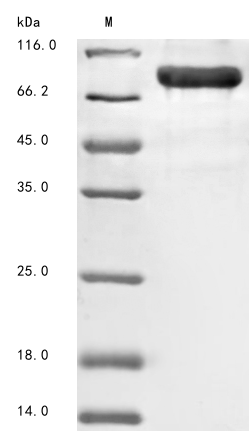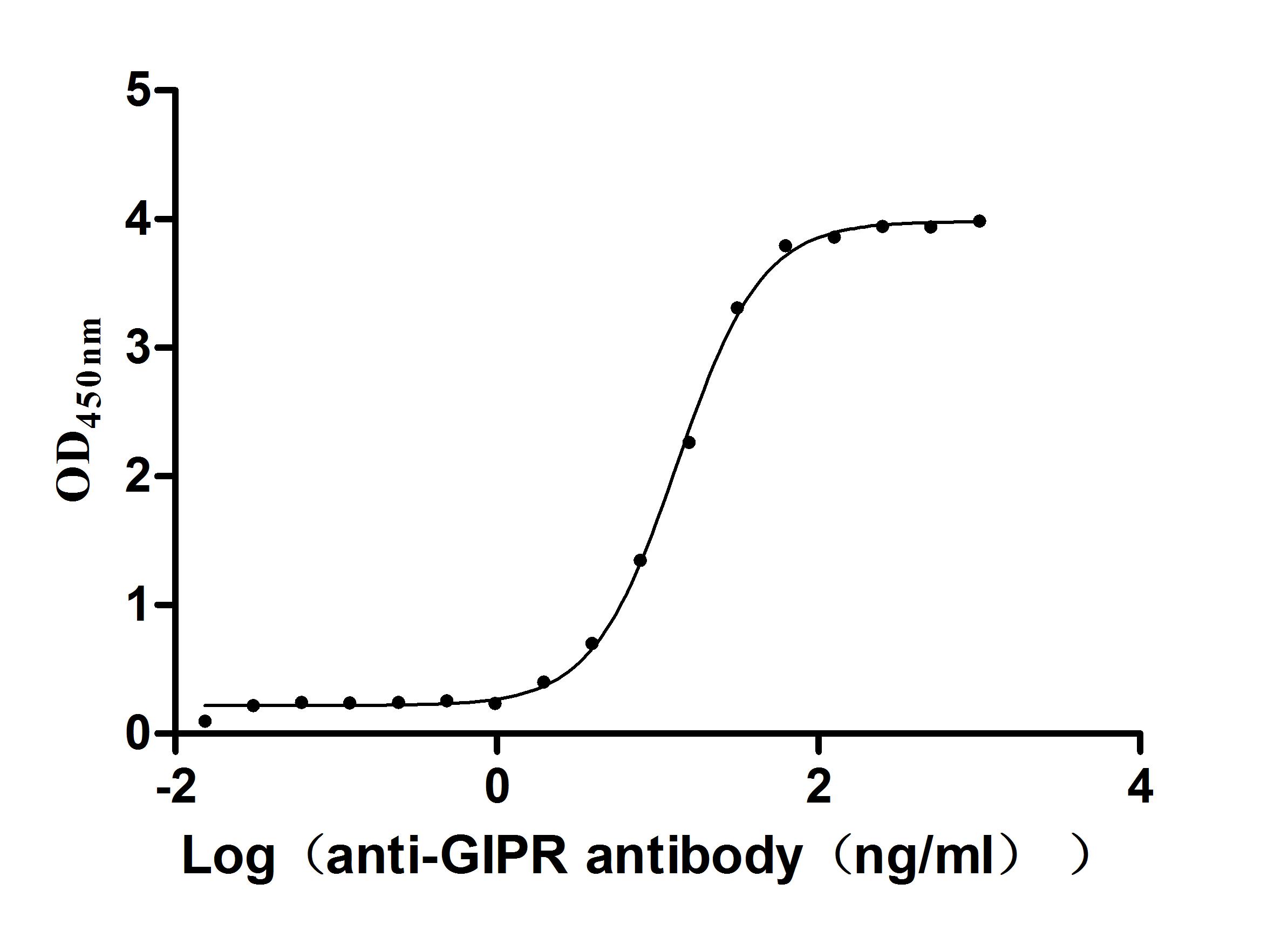Recombinant Mouse Receptor-interacting serine/threonine-protein kinase 1 (Ripk1)
In Stock-
中文名称:小鼠Ripk1重组蛋白
-
货号:CSB-EP720181MOa2
-
规格:¥1344
-
图片:
-
其他:
产品详情
-
纯度:Greater than 85% as determined by SDS-PAGE.
-
基因名:
-
Uniprot No.:
-
别名:Ripk1; Rinp; Rip; Receptor-interacting serine/threonine-protein kinase 1; EC 2.7.11.1; Cell death protein RIP; Receptor-interacting protein 1; RIP-1
-
种属:Mus musculus (Mouse)
-
蛋白长度:Full Length
-
来源:E.coli
-
分子量:87.8 kDa
-
表达区域:1-656aa
-
氨基酸序列MQPDMSLDNIKMASSDLLEKTDLDSGGFGKVSLCYHRSHGFVILKKVYTGPNRAEYNEVLLEEGKMMHRLRHSRVVKLLGIIIEEGNYSLVMEYMEKGNLMHVLKTQIDVPLSLKGRIIVEAIEGMCYLHDKGVIHKDLKPENILVDRDFHIKIADLGVASFKTWSKLTKEKDNKQKEVSSTTKKNNGGTLYYMAPEHLNDINAKPTEKSDVYSFGIVLWAIFAKKEPYENVICTEQFVICIKSGNRPNVEEILEYCPREIISLMERCWQAIPEDRPTFLGIEEEFRPFYLSHFEEYVEEDVASLKKEYPDQSPVLQRMFSLQHDCVPLPPSRSNSEQPGSLHSSQGLQMGPVEESWFSSSPEYPQDENDRSVQAKLQEEASYHAFGIFAEKQTKPQPRQNEAYNREEERKRRVSHDPFAQQRARENIKSAGARGHSDPSTTSRGIAVQQLSWPATQTVWNNGLYNQHGFGTTGTGVWYPPNLSQMYSTYKTPVPETNIPGSTPTMPYFSGPVADDLIKYTIFNSSGIQIGNHNYMDVGLNSQPPNNTCKEESTSRHQAIFDNTTSLTDEHLNPIRENLGRQWKNCARKLGFTESQIDEIDHDYERDGLKEKVYQMLQKWLMREGTKGATVGKLAQALHQCCRIDLLNHLIRASQS
Note: The complete sequence including tag sequence, target protein sequence and linker sequence could be provided upon request. -
蛋白标签:N-terminal 6xHis-SUMO-tagged
-
产品提供形式:Liquid or Lyophilized powder
Note: We will preferentially ship the format that we have in stock, however, if you have any special requirement for the format, please remark your requirement when placing the order, we will prepare according to your demand. -
缓冲液:Tris-based buffer,50% glycerol
-
储存条件:Store at -20°C/-80°C upon receipt, aliquoting is necessary for mutiple use. Avoid repeated freeze-thaw cycles.
-
保质期:The shelf life is related to many factors, storage state, buffer ingredients, storage temperature and the stability of the protein itself.
Generally, the shelf life of liquid form is 6 months at -20°C/-80°C. The shelf life of lyophilized form is 12 months at -20°C/-80°C. -
货期:3-7 business days
-
注意事项:Repeated freezing and thawing is not recommended. Store working aliquots at 4°C for up to one week.
-
Datasheet & COA:Please contact us to get it.
相关产品
靶点详情
-
功能:Serine-threonine kinase which is a key regulator of TNF-mediated apoptosis, necroptosis and inflammatory pathways. Exhibits kinase activity-dependent functions that regulate cell death and kinase-independent scaffold functions regulating inflammatory signaling and cell survival. Has kinase-independent scaffold functions: upon binding of TNF to TNFR1, RIPK1 is recruited to the TNF-R1 signaling complex (TNF-RSC also known as complex I) where it acts as a scaffold protein promoting cell survival, in part, by activating the canonical NF-kappa-B path...显示更多
-
基因功能参考文献:
- Ischemia induces an up-regulation of RIP1K and an enhancement of RIP1K-RIP3K complex formation in neurons and astrocytes. Inhibition of RIP1K increases ischemia-induced reduction in MAP2 or GFAP and decreases ischemia-induced neuronal or astrocytic cell necrosis in the ischemic cortex, and directly protects OGD-induced neuronal or astrocytic cell death. Nec-1 blocks RIP1K-RIP3K complex formation. PMID: 29102662
- Aldehyde dehydrogenase 2 deficiency negates chronic low-to-moderate alcohol consumption-induced cardioprotecion possibly via ROS-dependent apoptosis and RIP1/RIP3/MLKL-mediated necroptosis. PMID: 27840306
- The major function of RIP1 kinase activity in TNF-induced necroptosis is to autophosphorylate serine 161. This specific phosphorylation then enables RIP1 to recruit RIP3 and form a functional necrosome, a central controller of necroptosis. PMID: 28176780
- Elevated A20 promotes TNF-induced and RIPK1-dependent intestinal epithelial cell death PMID: 30209212
- two different modes of necroptosis induction by TNFalpha exist which are differentially regulated by iuRIPK1 formation. Overall, this work reveals a distinct mechanism of RIPK1 activation that mediates the signaling mechanism of RDA as well as a type of necroptosis. PMID: 29891719
- We show that inflammation and autoimmunity are prevented upon expression of kinase inactive RIPK1 or deletion of RIPK3 or MLKL. We provide evidence that the inflammation is not driven by microbial ligands, but depends on the release of danger-associated molecular patterns and MyD88-dependent signaling. PMID: 29212904
- RIPK1 kinase activity mediates TWEAK-induced apoptosis. PMID: 29588419
- RIPK1-DD has a role in mediating RIPK1 dimerization and activation of its kinase activity during necroptosis and RIPK1-dependent apoptosis PMID: 29440439
- High RIPK1 expression is associated with Alzheimer's disease. PMID: 28904096
- The s report here that male reproductive organs of both Ripk3- and Mlkl-knockout mice retain 'youthful' morphology and function into advanced age, while those of age-matched wild-type mice deteriorate. Feeding of wild-type mice with an RIPK1 inhibitor prior to the normal onset of age-related changes in their reproductive organs blocked the appearance of signs of aging. PMID: 28807105
- Pull down experiments with biotinylated Sorafenib show that it binds independently RIPK1, RIPK3 and MLKL. Moreover, it inhibits RIPK1 and RIPK3 kinase activity. In vivo Sorafenib protects against TNF-induced systemic inflammatory response syndrome (SIRS) and renal ischemia-reperfusion injury (IRI). PMID: 28661484
- The study provides genetic evidence that different RIP1 kinase inactive mutations have distinct impacts on the embryogenesis of Fadd-deficient mice. PMID: 28574501
- Excessive death of hepatocytes is a characteristic of liver injury. A new programmed cell death pathway has been described involving upstream death ligands such as TNF and downstream kinases such as RIPK1. PMID: 28088582
- TNFalpha-induced phosphorylation of RIPK1 in the intermediate domain by TAK1 plays a key role in regulating the decision between three distinct mechanisms of cell death: necroptosis, RIPK1-independent and dependent apoptosis. PMID: 28842570
- K45 mediated kinase activity of RIPK1 is not only important for necroptosis but it also has a key role in promoting cytokine signaling and host response to inflammatory stimuli. PMID: 27258786
- Data show that the kinase activity of receptor-interacting protein kinase 1 (RIPK1) is required for Yersinia-induced apoptosis. PMID: 28855241
- An alternative function for RIPK1/RIPK3 in vascular permeability. PMID: 28151480
- these results revealed a novel, kinase-independent function of RIP1, which is essential for not only promoting TCR-induced proliferative responses but also in blocking apoptosis in mature T cells. PMID: 27685623
- Data show that the kinase domain of RIPK1 is a disease driver of intracerebral hemorrhage, mediating both acute cell death and functional outcome. PMID: 28765287
- study identifies a novel role for RIPK1 and RIPK3, a pair of homologous serine/threonine kinases previously implicated in the regulation of necroptosis and pathologic tissue injury, in directing IFN-beta production in macrophagesges. PMID: 28461567
- this study shows that RIPK1 and RIPK3 account for acute inflammatory responses induced by lipopolysaccharide in vivo; notably, this regulation does not require exogenous manipulation of caspases PMID: 27396959
- these findings indicate that RIPK1 cooperates with NF-kappaB signaling to prevent TNFR1-independent hepatocyte apoptosis and the development of chronic liver disease and cancer, but acts downstream of TNFR1 signaling to promote diethylnitrosamine-induced liver tumorigenesis. PMID: 28628031
- this study reveals a critical kinase-independent platform role for RIPK1 in protecting against TNF/caspase-dependent apoptosis of hepatocytes in immune-mediated liver injury PMID: 27605011
- Results revealed that RIPK1 and PGAM5 function independently to exert optimal control of Leishmania replication in the host. PMID: 27183605
- Knocking down receptor-interacting serine/threonine protein kinase 1 (Ripk1) increased both intracellular and extracellular PGRN protein levels by increasing the translation rate of PGRN without affecting mRNA levels. PMID: 28069809
- The findings reported here indicate that palmitate induces RIP1/RIP3-dependent necrosis via MLKL-mediated pore formation of RAW 264.7 cells in the plasma membrane, which could provide a new mechanism to explain the link between elevated levels of free fatty acids (FFAs), palmitate in particular, and macrophage death. PMID: 27856241
- The results indicate that RIP1 and MLKL contribute to necroptotic cell death after HCoV-OC43 infection to limit viral replication. PMID: 27795420
- Overall, our study has identified a new role of PS-341 in the cell death of BMDMs and provided a novel insight into the atherosclerotic inflammation caused by proteasome-mediated macrophage necroptosis. PMID: 27363341
- this study reveals a unique response of Kupffer cells against liver ischemia reperfusion, that is, RIP1-dependent necrosis, which constitutes a novel mechanism of liver inflammatory immune activation in the pathogenesis of liver ischemia reperfusion injury PMID: 28289160
- RIPK1 prevents skin inflammation by inhibiting activation of RIPK3-MLKL-dependent necroptosis mediated by Z-DNA binding protein 1 (ZBP1, also known as DAI or DLM1). PMID: 27819681
- findings indicate that the RHIM of RIPK1 is critical for preventing ZBP1/RIPK3/MLKL-dependent necroptosis during development PMID: 27819682
- Hyperglycemic Conditions Prime Cells for RIP1-dependent Necroptosis. PMID: 27129772
- CNOT3 suppression promotes necroptosis by stabilizing mRNAs for cell death-inducing proteins, Ripk1 and Ripk3. PMID: 26437789
- TAKI-induced cytotoxicity is cell context specific, and apoptosis observed in macrophages is dependent on the constitutive autocrine action of TNF-alpha for RIP1 activation and ROS production. PMID: 26381601
- RIP1-Tag2 mice that lack serglycin develop larger tumors. PMID: 25978773
- data show that RIP1-mediated necroptosis is not present in the postischemic liver and that I/R-induced caspase activation is associated with loss of RIP1 expression PMID: 26009812
- In addition to other pro-death functions, RIP1 regulates cellular sensitivity to pro-death stimuli by modulating basal autophagy. PMID: 25908842
- Cisplatin stimulates RIP1/RP3/MLKL-dependent necrotic cell death in renal tubules, which finally causes renal dysfunction PMID: 25788533
- diverse modes of acute liver injury have differing requirements for RIP1 and RIP3; moreover, within a single injury model, RIP1 and RIP3 blockade can have diametrically opposite effects on tissue damage PMID: 25950489
- Results demonstrate that RIPK1 is a bona fide substrate of IKKa and IKKb and that IKKa/IKKb-mediated phosphorylation of RIPK1 in complex I protects cells from RIPK1 kinase-dependent death. PMID: 26344099
- Human herpesvirus 1 ICP6 interacts with mouse RIP1/RIP3 through its RHIM domain and forms dimers/oliogmers by its C-terminal R1 domain. PMID: 25674982
- robust cross-priming required receptor-interacting protein kinase-1 (RIPK1) signaling and nuclear factor kappaB (NF-kappaB)-induced transcription within dying cells. PMID: 26405229
- RIP1 and RIP3-mediated necroptosis may involve in the pathogenesis of aplastic anemia induced by cyclophosphamide and busulfan in mice. PMID: 25674205
- RIP1 plays a major role in physiological enterocyte turnover through a RIP3-independent nonapoptotic death mechanism in the mouse small intestine. PMID: 25348793
- RIPK1 indirectly regulates caspase-8 activation, in part via interaction with the ER stress sensor IRE1. PMID: 25476903
- The presence of RIPK1, either in the initial dimer or as a secondary recruit, increases the efficiency of induction of apoptosis. PMID: 24902899
- Data show that hematopoietic receptor-interacting serine/threonine-protein kinase 1 (RIPK1) deficiency triggers both apoptotic and necroptotic death that is partially prevented by receptor-interacting serine-threonine kinase 3 (RIPK3) deficiency. PMID: 25246544
- Treatment with pan-caspase inhibitor ZVAD blocked the activation of caspase-8 and reduced the number of apoptotic nuclei, while increasing levels of RIP1, RIP3, and necrotic OHCs. PMID: 24874734
- our results reveal a specific role for the RIP1-RIP3-DRP1 pathway in RNA virus-induced activation of the NLRP3 inflammasome PMID: 25326752
- Although necrostatin inhibited TNF-induced, lipopolysaccharide-induced and polyIC-induced necroptosis, RIPK1 knockdown unexpectedly potentiated this process. RIPK1 is dispensable for necroptosis and can act as an inhibitor of it. PMID: 25195660
收起更多
-
亚细胞定位:Cytoplasm. Cell membrane.
-
蛋白家族:Protein kinase superfamily, TKL Ser/Thr protein kinase family
-
组织特异性:Found at low levels in all tissues.
-
数据库链接:
KEGG: mmu:19766
STRING: 10090.ENSMUSP00000021844
UniGene: Mm.374799


















